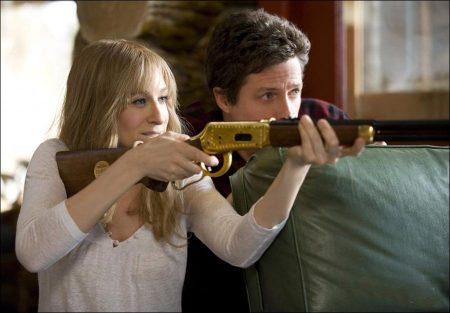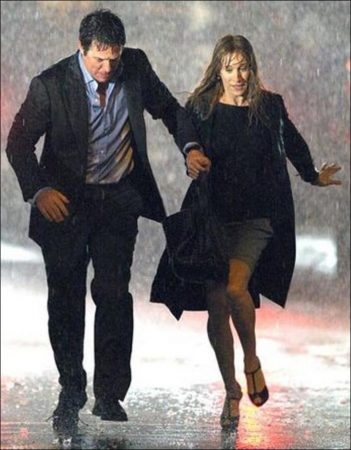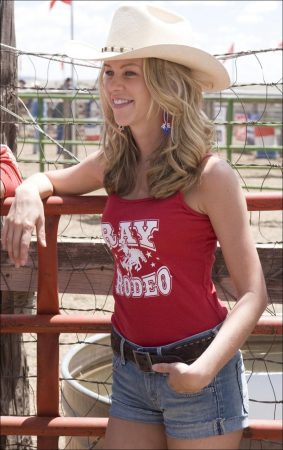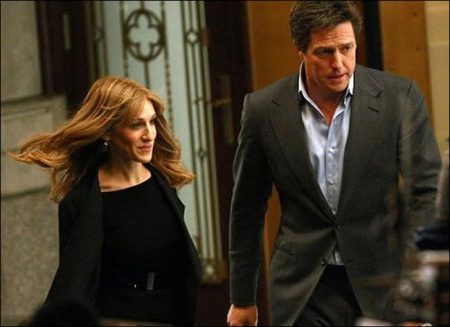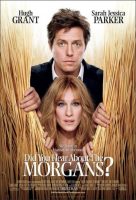Tagline: We’re not in Manhattan anymore.
Did You Hear About the Morgans movie storyline. A highly successful Manhattan couple, Meryl and Paul Morgan (Sarah Jessica Parker and Hugh Grant), whose almost-perfect lives have only one notable failure – their dissolving marriage. But the turmoil of their romantic lives is nothing compared to what they are about to experience:
They witness a murder and become targets of a contract killer. The Feds, protecting their witnesses, whisk away the Morgans from their beloved New York to a tiny town in Wyoming, and a relationship that was on the rocks threatens to end completely in the Rockies… unless, in their new BlackBerry-free lives, the Morgans can slow down the pace and rekindle the passion.
Did You Hear About the Morgans? is a 2009 American romantic comedy thriller film directed and written by Marc Lawrence. Golden Globe winners Hugh Grant and Sarah Jessica Parker portray the film’s protagonists, Paul and Meryl Morgan, a recently separated New York power couple on the verge of divorce until they witness the murder of Meryl’s client. They are forced to enter into temporary witness protection, given new identities, and relocated to a small Wyoming town (the fictional Ray, Wyoming, 45 minutes out of Cody). Supporting roles are played by Sam Elliott, Academy Award winner Mary Steenburgen, Elisabeth Moss, and Wilford Brimley. It is the second collaboration of Grant and Parker, following the 1996 film Extreme Measures.
The film premiered in New York on December 14, 2009 and in London the following day. It was released to the United States on December 18 and to most of Europe in January 2010. It received mostly negative reviews from critics. Compiled ratings from the review aggregator website Rotten Tomatoes gave the film an average rating of 3.5 out of 10. The film grossed $6,616,571 in its opening weekend and earned $85 million worldwide. Did You Hear About the Morgans? was the 70th most successful film worldwide for 2009.
About the Film
“The idea first popped up 10 or 11 years ago,” says Lawrence. “It was a project I’d start and then put away, and I’d keep coming back to it. They say ‘write what you know,’ and for me, the problem with that is I don’t know anything. I never leave my apartment. The only thing I know about is marriage – I met my wife in college and I’ve been married a long, long time.”
But the Morgans’ is not just any marriage. “It’s a marriage in trouble,” notes Lawrence. “These two people have lost their connection specifically because of an infidelity, but the root of the problem is that they had grown apart.”
Hugh Grant, who plays Paul Morgan, sets the scene: “Paul is trying desperately to get Meryl back. And he takes her out for dinner, and on the way back from dinner they witness a murder. They become very important witnesses. The killer has seen them, so the FBI sends them into the witness protection scheme.”
Lawrence utilizes this fish-out-of-water scenario of the Witness Protection Program as an exciting new way to force the couple to face their issues in the wilds of Ray, Wyoming. “This high maintenance New York couple,” explains Grant, “are sent into the Witness Protection scheme in a tiny cowboy town in Wyoming, and that has interesting effects on their marriage.”
Sarah Jessica Parker, who plays Meryl Morgan, notes that this premise for a romantic comedy stood out from her previous projects. “I liked its whimsy. I haven’t played somebody like Meryl. I haven’t played somebody in a marriage like hers.”
Shooting in New York
The shoot began in New York City, and Marc Lawrence had assembled a fantastic production team that also happened to be quite familiar with making films in the Big Apple: Florian Ballhaus as the director of photography and Kevin Thompson as production designer.
Sarah Jessica Parker recalls recommending Thompson, who had designed Stranger Than Fiction and Igby Goes Down, for the job. “I said there’s a guy I’ve been wanting to work with for years,” says Parker. “He’s so good, he’s so talented, he’s so special, but he doesn’t travel. He doesn’t like to leave New York.”
“I met with Marc because I read the script and I really enjoyed it. It’s a genre that I don’t normally do,” says Thompson. “We immediately clicked about the experience of the story, the idea of living in New York for a long time, and then going to other parts of the country. I think people really would seem alien at first.”
Florian Ballhaus, who previously worked with Parker as the director of photography on the last season of “Sex and the City,” was behind the camera. “Florian was just fantastic,” says Lawrence. “It’s the kind of relationship with a cinematographer that I’ve always hoped to have. He’s incredibly skilled, amazingly easygoing, and very collaborative, and as if that weren’t enough, he’s funny. If they let me make another movie, he’s the first call.”
Thompson’s challenge with the design for the Morgans’ life in New York was to capture the couple’s socio-economic status, as well as the emotional temperature. Their Upper East Side apartment at the start of the film “felt a little bit like things were missing in their life,” he explains. “Paul had moved out. There was a void. They have a dining room, but instead of using it for dinner parties, Meryl uses it to work.”
The Morgans’ apartment also served as the location for a very tricky stunt in which Meryl Morgan climbs along the ledge of her building to escape the hit man, who has tracked her down in the city. Thompson points out the apartment they needed didn’t exist in one space, so for the stunt they built the façade of the balcony on the stage at Steiner Studios in the Brooklyn Navy Yard.
Of course, the New York sets would have to exhibit a stark contrast with the rest of the film, set in Wyoming. “We really made a conscious effort to shoot New York differently,” says Lawrence. “The clothes would be different, the colors of the sets would be different, even the camera angles and score would be different. The idea was that in the New York scenes, you would really feel the pulse and pace of the streets, so we could contrast that with Wyoming.”
Thompson also considered the look of the city on the whole within the context of the movie itself. “We tried to create a neighborhood and environment for them and get enough diversity of what classic New York is like and what high end New York is like so that it would be diametrically opposed to what their experience would be like when they got to Wyoming,” Thompson explains.
Another department that had to artistically and visually delineate the two worlds of New York and Wyoming for the film was wardrobe. Costume designer Christopher Peterson, who had worked with Lawrence on Music and Lyrics, stepped up to the challenge, despite initial intimidation about styling Sarah Jessica Parker.
…And Shooting in The Wild, Wild West
If it seems Marc Lawrence is an unlikely candidate to set a film in Wyoming, well, according to the people who know him, the word “unlikely” doesn’t begin to describe it. According to co-producer Melissa Wells, who has worked with Lawrence for years, “We shot Music and Lyrics within ten blocks of Marc’s apartment. Marc is a New Yorker at heart. He gets the Mets games on his iPhone and he eats a bagel every day.”
“Marc is a man who doesn’t like to leave the Upper West Side of New York,” notes Hugh Grant. “For him, Central Park is too much nature, so to really have written this, set out here in the west, involving beasts, is for him a strange form of masochism.”
Masochism or sadism? After all, it was Grant and Parker who would have the toughest jobs, completing all the tasks that physical comedy demanded of them. “Riding horses, riding fake horses, jogging in the freaking desert take after take after take. I mean, there were some occasions where I thought, ‘They just think this is funny now. They’re not cutting because they think it’s funny to watch me struggle,’” says Parker.
Another case in point: handling a rifle. The script required Parker to fire the gun several times. “Obviously, Hugh and S.J. had to have the gun safety classes – they had to know how to handle the guns,” says Lawrence. “Of course, the guns wouldn’t really be loaded, but you have to do that. At the same time, I didn’t want them to be too comfortable with the guns – this character is very Democrat, very liberal. S.J. had to know what she was doing, but Meryl couldn’t.”
So, the question became: where to shoot? “At the beginning, I think Marc and Kevin Thompson were joking, ‘Well, maybe we can shoot the Wyoming scenes in Central Park. Connecticut at worst,” kids Wells. “There’s a joke in the script – Marshal Lasky says to Meryl, ‘Would you rather leave New York or die in New York?’ And she has to think about it for a moment. I think that’s basically Marc’s answer to that question.”
All kidding aside, Lawrence knew what he’d need for the movie to work: “This couldn’t be a Hollywood town and it couldn’t be the type of town that two New Yorkers could show up and say, ‘Oh, this is charming,’” he says. “It had to be a real, functioning town.”
When the time came to choose a shooting location, they had their pick of the wide open spaces of the western United States. They discovered that the state of New Mexico had everything they would require – not least of which was the quaint but no-nonsense town of Roy, with a population of just 300 people. The town would become the inspiration for Lawrence to dub the scripted town “Ray” and where the crew spent their last five shoot days in New Mexico, roughing it just as Paul and Meryl do in the script.
“I think Hugh really looked forward to it,” says Lawrence. “He had an Englishman’s fascination with the American west, like some Americans do about the English countryside – ‘Oh, we’ll see these little English villages and it’ll all be very Dickensian’ – except it’s all about cowboy hats and horses. Me, I was already unhappy. I would say that S.J. and I would be perfectly happy if we never left New York. So we get there, and all the people could not have been nicer, and everybody was lovely, but… well, I just do not like being away from home. It’s all rodeos and dust and manure and animals. I panicked at not being able to order Chinese food. I kissed the tarmac at Kennedy when we got back.”
As the story of how they found Roy goes, New Mexico location manager David Manzanares’ wife was in Roy taking scout pictures when a local woman named Tuda Crews came out of Annette’s Restaurant and asked her what she was doing. Crews, whose family has been in Roy for seven generations, has been very active in trying to revitalize the town, which has been struggling in recent years. Crews became a sort of unofficial ambassador to the film for Roy.
It would be townsfolk like Tuda, from the local ladies that baked cakes and brought them to the set, to the countless other residents that served as extras, that most delighted Lawrence and the rest of the crew about using this town for the shoot.
The next steps were for Thompson, Ballhaus, Wells, and Lawrence to make the journey to this remote town to scout for filming. “We basically drove around and didn’t know what we were looking for,” Thompson explains, “And you can stand on one end of town and you can see the other end of town. And I think that’s the thing that really made us love this town, was that you physically saw yourself arriving and leaving all within a couple minutes.”
As a production designer, Thompson was drawn to Roy’s rustic charm. “One of the things I love about Roy is that it has a water tower. And everywhere you are you see the water tower. So there’s an identifying feature that makes it feel like a small town.”
It was clear they had found their location, which meant there were a host of challenges to address. For starters, where would they live? “Anthony Katagas, our executive producer, said, ‘What we’ll do is we will set up all the trailers in the parking lot of the high school and we’ll live there. And you can either shower in your trailer or you can shower in the gym of the high school.’ And to me this sounded like the worst idea I’d ever heard in my life.” But that’s what they did, setting up a summer camp-like atmosphere that came to be called Camp Roy.
Whether it was games of charades (often organized by Steenburgen) or “assassin” (in which people were assigned random targets for “assassination” by pinning them sneakily with a clothespin), many members of the cast and crew found themselves reverting back to their childhood at Camp Roy. “If you can’t be shooting a movie in New York and getting to go home at night, then Camp Roy is a great experience,” says Parker.
Thompson began his work transforming this small New Mexico town into Wyoming, as there are many regional inconsistencies he would have to address: “I did a great deal of visual research, not only in terms of the landscape, but the architecture and the details of the culture there…and clothing, fabric, furniture. There are lots of things that are specific to Wyoming.”
Thompson also had to contrast the western setting with the cold, contemporary design of the New York sets. “We wanted New York to be in sharp contrast to what they were going to experience when they went to Wyoming. We didn’t want to do a typical western town that had stereotypical western details…we wanted it to be more real and to have kind of mundane qualities that would make them feel more alien at first. And then slowly make the characters and the setting and the town that they’re in feel warmer and more inviting.”
Perhaps one of the best compliments Thompson received for his authenticity in executing Ray was from the true Western actor on set. “Sam Elliott, who is very particular about the details of his character and wardrobe and vehicle and guns and all that was, he had taken me aside and was extremely pleased with the level of thought and detail that went into his character’s work area,” says Thompson.
“We wanted to represent that these people that lived there are middle class,” Thompson explains of the Wheeler’s lifestyle. “Not everything is pretty…they took care of things, so they had a lot of older things. But they weren’t necessarily antiques. Things were more useful and utilitarian and less aesthetic.”
For Clay and Emma’s cabin, the filmmakers found a beautiful exterior on Val Kilmer’s ranch in the Pecos Valley, outside of Sante Fe. He continues: “When you first arrive at the cabin you want Paul and Meryl to feel like ‘Oh my God, how are we gonna do this?’ And then they cozy in. And so it had to be an environment that could sort of be seen both ways. And I think the longer you spend there, the more familiar you are. And then it doesn’t seem so bad. But, you know, they weren’t shy about having their water heater exposed in the kitchen…and the animals that they hunted on the walls.”
To complete the Western lifestyle design, costumer Christopher Peterson took an actual trip to Wyoming to shop for authentic clothing. “The first scene in Wyoming takes place with Hugh and Sarah Jessica shopping in a Costco or Walmart-like environment,” Peterson explains. “We went to Wyoming for two weeks and shopped Wyoming…We went into the stores, my assistant and I, and it’s mighty real. That’s all I have to say.”
Shopping with an eye that a New Yorker would have in those stores, Peterson accumulated tons of clothing and brought it back to New York for Parker and Grant to “shop” for themselves. “I had assembled this Bargain Barn environment for them and I let them go through the racks and sort of find those things that they responded to.”
Dressing Steenburgen and Elliott was a less complicated matter. “Mary Steenburgen and Sam Elliott were a complete joy to work with and brought so much to the role that clothes are never going to,” says Peterson. “They wear this look well because they’re both familiar with it. Sam has an extensive background in Westerns and… Mary is a girl from Arkansas and so she gets it. They get the cowboy hat. They know about the belt. They know about the boots.”
In fact, Elliott already owned so much of his character Clay’s wardrobe that he simply brought some of it to the set. “It’s always nice to be able to wear your own hat,” he says. “I had one hat that worked for this. It’s all about the hat.”
Steenburgen was just as pleased with Emma’s clothing in the film. “I have to say these are my favorite clothes of any movie I’ve ever done because all I wear is jeans and cowboy boots,” she says.
“One thing I learned in doing this movie is that every single piece of clothing that a cowboy or cowgirl wears has a meaning and makes total sense,” Steenburgen continues. “The hat you need because you’re out in the sun and the elements. The scarf, it’s so important when you’re out and it’s dusty…And the gloves I wear sometimes because your hands literally get sunburned when you’re holding the reins…and then the boots, we all know what the boots are, and the jeans make sense.”
Roy Mayor Fluman acknowledges that hosting a film shoot was a boon to the neighborhood. “Sony Pictures set up a town hall meeting to visit with the people in town and explain the different things that would happen in the community. Then the crew came in to start fixing up the buildings. So it’s been pretty exciting. I knew right away that it would be an economic boost to the community.”
The cast and crew fell in love with the tiny town and its welcoming citizens, so they were happy to make sure the film shoot gave as much support as possible to Roy’s businesses and community at large, from using Roy’s own Annette’s restaurant for a location, to identifying community programs that needed funding.
The sentiment was bittersweet for Parker. “It made me very sad that that town, like so many in America, hundreds and hundreds of towns are just dying. Big highways and bypasses have changed America so much and they’re a perfect example of that. I think the train stopped coming to Roy and basically…once you lose that kind of commerce, it’s very hard when you’re that far away to thrive as a community.”
Moving out of Roy for the climactic rodeo scene, when Paul and Meryl face Vincent in front of the whole town, Thompson and the crew wanted to find a rodeo that would be the appropriate size for a small Western town. “We found an amazing rodeo in Galisteo, this little rodeo that’s open once a year,” says Wells.
“The rodeo was really run down, but it had the skeleton of what we wanted. It was the right scale. And it had sort of a nice feeling. We just walked around it and felt good being there. So we took that skeleton and we figured out how we could enliven it without making it too Hollywood and too big time,” says Thompson.
About the Bear and the Cow
Perhaps the most harrowing of Paul and Meryl’s western adventure – aside from the hitman who wants to take them out – is the bear that accosts Paul outside of Clay and Emma’s cabin. Naturally, this required the production to find a bear, and they got the best – Bart the Bear, who previously appeared in Dr. Dolittle 2, Without a Paddle, and Into the Wild.
“The bear scene started as a terrifying experience,” remembers Grant. “However much they tell you this bear’s been brought up as a human, which it was…when it steps out of its trailer and it’s sixteen feet tall and you’ve been told not to look it in the eye, it’s intimidating.”
“I stood behind Hugh,” says Lawrence. “I figured, if it all went wrong, let the bear get Hugh first. We were all tense. We had this big safety meeting. Somebody in the crew said, ‘So, you guys have tranquilizer guns,’ and they said, ‘No, we don’t, he’ll be fine.’”
“I was really, really afraid of the bear,” adds Parker. “Hugh had made a lot of proclamations – ‘I’m scared of the bear. I don’t want to be near the bear. Where’s the bear? How far am I from the bear?’ He let the bear get so close to him before he ran. His cowardice is all talk.”
Grant admitted by the end of the day working with the bear, the intimidation had had eased. “I would have happily sat down and had lunch with it. I mean, it was a pussycat by the end of the day, really.”
According to Grant, the bear was a bit of a diva. “It wouldn’t come out of his trailer until it had been washed and brushed, and then when it did come out, it had to be given eight cans of iced tea every time it hit its mark – and not only eight cans of iced tea, but also whipped cream in a sauce pan,” Grant explains. “If it got its whole thing right, everyone had to applaud and cheer and say ‘Yeah, right on! Way to go, bear!’ And it loved the applause.”
“By the time we got to the tenth take, everyone was just walking by and saying hi to the bear and he’s hanging out drinking an iced tea – he likes iced tea – and by the end of the day the trainers were a little concerned that we were all so close to the bear,” says Lawrence. “It’s like anything else in movies – at the beginning, you’re tense, and by the twentieth take, you’re exhausted and you don’t care that there’s a large man-eating mammal two feet from you because he’s just as exhausted and tired as you are.”
A similarly interesting animal experience for Parker was her, at times, violent interactions with the on-set cow, for a scene in which Clay teaches Meryl how to milk. “I was kicked by the cow, but I don’t blame the cow,” Parker admits. “I mean, if the cow could speak I’m sure she would say, you know, I don’t really want to be milked for six hours straight…It was pretty funny. Sam Elliott would just back up. I would run and scream.”
The scene was originally written to take place between Emma and Meryl, with Clay and Paul sharing a moment over chopping wood. “So Marc comes with this idea of switching the characters around,” Elliott remembers, “I resisted initially, resisted the milking of the cow scene. I resisted us having cows, period…But Marc’s the director, so we did it his way, and he was right – it was a great choice.”
Did You Hear About the Morgans? (2009)
Directed by: Marc D. Lawrence
Starring: Sarah Jessica Parker, Hugh Grant, Elisabeth Moss, Mary Steenburgen, Sam Elliott, Sharon Wilkins, Vincenzo Amato, Kim Shaw, Steven Boyer, Natalia Klimas, Jesse Liebman, Michael Kelly
Screenplay by: Marc D. Lawrence
Production Design by: Kevin Thompson
Cinematography by: Florian Ballhaus
Film Editing by: Susan E. Morse
Costume Design by: Christopher Peterson
Set Decoration by: Susan Bode
Art Direction by: Stephen H. Carter
Music by: Theodore Shapiro
MPAA Rating: PG-13 for Some sexual references and momentary violence.
Distributed by: Columbia Pictures
Release Date: December 18, 2009
Views: 106
